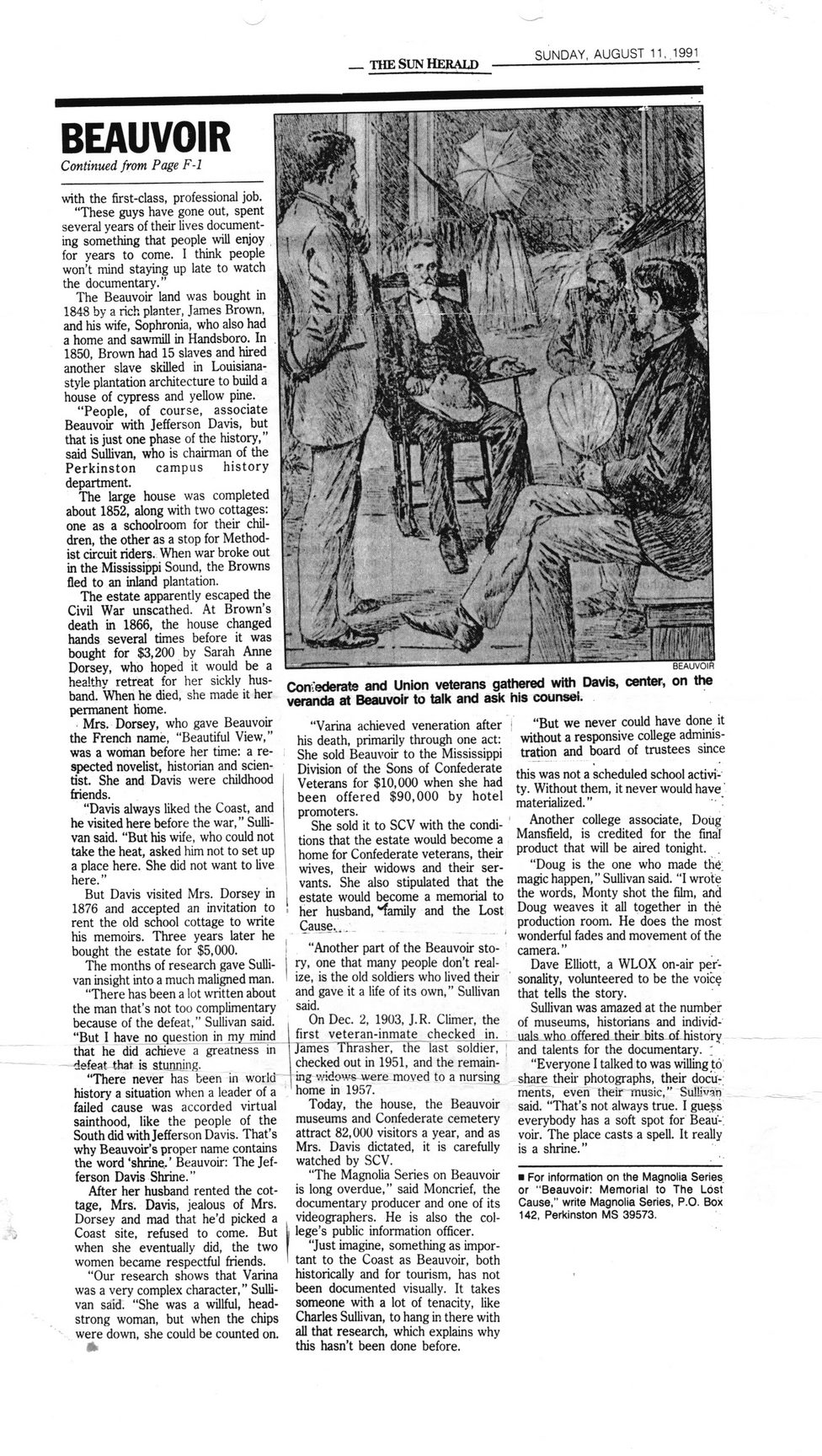This text was obtained via automated optical character recognition.
It has not been edited and may therefore contain several errors.
_ THE SUN HERALD SUNDAY, AUGUST 11, 1991 BEAUVOIR Continued from Page F-l with the first-class, professional job. “These guys have gone out, spent several years of their lives documenting something that people will enjoy for years to come. 1 think people won’t mind staying up late to watch the documentary.” The Beauvoir land was bought in 1848 by a rich planter, James Brown, and his wife, Sophronia, who also had a home and sawmill in Handsboro. In 1850, Brown had 15 slaves and hired another slave skilled in Louisiana-style plantation architecture to build a house of cypress and yellow pine. “People, of course, associate Beauvoir with Jefferson Davis, but that is just one phase of the history,” said Sullivan, who is chairman of the Perkinston campus history department. The large house was completed about 1852, along with two cottages: one as a schoolroom for their children, the other as a stop for Methodist circuit riders. When war broke out in the Mississippi Sound, the Browns fled to an inland plantation. The estate apparently escaped the Civil War unscathed. At Brown’s death in 1866, the house changed hands several times before it was bought for $3,200 by Sarah Anne Dorsey, who hoped it would be a healthy retreat for her sickly husband. When he died, she made it her permanent home. Mrs. Dorsey, who gave Beauvoir the French name, “Beautiful View,” was a woman before her time: a respected novelist, historian and scientist. She and Davis were childhood friends. “Davis always liked the Coast, and he visited here before the war,” Sullivan said. “But his wife, who could not take the heat, asked him not to set up a place here. She did not want to live here. ” But Davis visited Mrs. Dorsey in 1876 and accepted an invitation to rent the old school cottage to write his memoirs. Three years later he bought the estate for $5,000. The months of research gave Sullivan insight into a much maligned man. “There has been a lot written about the man that’s not too complimentary because of the defeat, ” Sullivan said. "But I have no question in my mind that he did achieve a greatness in defeat that is stunning. “There never has been in world history a situation when a leader of a failed cause was accorded virtual sainthood, like the people of the South did with Jefferson Davis. That’s why Beauvoir’s proper name contains the word ‘shrine. ’ Beauvoir: The Jefferson Davis Shrine.” After her husband rented the cottage, Mrs. Davis, jealous of Mrs. Dorsey and mad that he’d picked a Coast site, refused to come. But when she eventually did, the two women became respectful friends. “Our research shows that Varina was a very complex character, ” Sullivan said. “She was a willful, headstrong woman, but when the chips were down, she could be counted on. Confederate and Union veterans gathered with Davis, center, on the veranda at Beauvoir to talk and ask his counsel. “Varina achieved veneration after his death, primarily through one act: She sold Beauvoir to the Mississippi Division of the Sons of Confederate Veterans for $10,000 when she had been offered $90,000 by hotel promoters. She sold it to SCV with the conditions that the estate would become a home for Confederate veterans, their wives, their widows and their servants. She also stipulated that the estate would become a memorial to her husband, “family and the Lost Cause.... “Another part of the Beauvoir story, one that many people don’t realize, is the old soldiers who lived their and gave it a life of its own, ” Sullivan said. On Dec. 2, 1903, J.R. Climer, the first veteran-inmate checked in. James Thrasher, the last soldier, checked out in 1951, and the remaining widows were moved to a nursing home in 1957. Today, the house, the Beauvoir museums and Confederate cemetery attract 82,000 visitors a year, and as Mrs. Davis dictated, it is carefully watched by SCV. “The Magnolia Series on Beauvoir is long overdue,” said Moncrief, the documentary producer and one of its videographers. He is also the col-| lege’s public information officer. I “Just imagine, something as impor-' tant to the Coast as Beauvoir, both historically and for tourism, has not been documented visually. It takes someone with a lot of tenacity, like Charles Sullivan, to hang in there with all that research, which explains why this hasn’t been done before. j “But we never could have done it without a responsive college administration and board of trustees since this was not a scheduled school activity. Without them, it never would have materialized.” ' Another college associate, Doug Mansfield, is credited for the final product that will be aired tonight. “Doug is the one who made th£ magic happen,” Sullivan said. “I wrote the words, Monty shot the film, and Doug weaves it all together in the production room. He does the most wonderful fades and movement of the camera. ” Dave Elliott, a WLOX on-air personality, volunteered to be the voice that tells the story. Sullivan was amazed at the number of museums, historians and individuals who offered their bits of history and talents for the documentary. ' “Everyone I talked to was willing to share their photographs, their documents, even their music,” Sullivan said. “That’s not always true. I guess everybody has a soft spot for Beauvoir. The place casts a spell. It really is a shrine.” ■ For information on the Magnolia Series or “Beauvoir: Memorial to The Lost Cause,” write Magnolia Series, P.O. Box 142, Perkinston MS 39573.

BSL 1991 To 1995 Beauvoir Documentary (3)